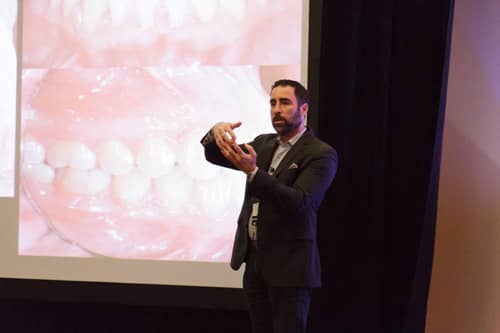Sponsored by
Glenn Krieger, DDS, MS, FAGD, promised a lot with his lecture at the recent HSO Orthodontic Excellence & Technology™ Symposium in Scottsdale, Ariz, and he delivered. Titled “Increased Case Acceptance, Amazing Clinical Images, and Lower Stress,” Krieger talked about the relationship between clinical photography and case acceptance. What’s more, he segued into how implementing the SAGITTAL FIRST concept into his practice has improved his treatment outcomes.
“Clinical photography has always been touted as one of those things that we have to have for great records—we can’t move forward without awesome records. Yet virtually every orthodontic program, virtually every dental program in the world, does not focus a considerable amount of time on photography. So, what ends up happening is that [residents] get trained in all these techniques, materials, and tools and then they get out of school and think they know how to document,” Krieger said in an interview with Orthodontic Products ahead of his lecture.
Krieger spent 20 years as a restorative dentist before completing his residency in orthodontics 3 years ago. Based on his experience, he developed this concept, called Digital Co-Diagnosis, which relies on exceptional images of people’s teeth and motivational interviewing to give them a better understanding of their diagnosis.
“We tend to jump in and try to give people answers to their problems before they understand their diagnosis,” said Krieger. “I found that if I spend 90% of the time just letting [the patient] walk down the path using exceptional images, that they then didn’t even care what the treatment was. They just wanted to fix it.
“What I’m speaking about [at the Symposium] is the fact that we can have this transformative way of changing our practice’s case acceptance and our patient engagement. We never have to have a person ask, ‘Why are we doing this again?’”
Krieger’s lecture explained how to get those images and the verbal cues that go along with motivating the patient. During our interview, he provided an example to illustrate how this process works. While looking at the patient’s pictures with the patient, the key is to ask them what they see: “When you see the teeth here, do they look like they’re coming together like a set of gears the way they’re supposed to? Or do they look like they’re kind of hitting against each other like rocks on rocks?” If the patient answers, “Kind of like rocks on rocks,” the orthodontist then says, “Well, would you agree with me that it’s probably a little bit healthier for them to hit like a set of gears?” The patient responds, “Yes,” and this provides an opportunity for the orthodontist to say, “Great. Do you mind if I talk to you about some solutions?”
As Krieger pointed out, it’s not about talking the patient into treatment or coercing them in any way. It’s about making sure the patient completely understands their case and understands the pros and cons of accepting or declining treatment. “And I haven’t even talked to [the patient] about a treatment plan. I’ve just said, ‘Do you see this? This is a concern, right? Should we address it? Sure. Do you need me to go into the details of how?’ Probably not, but I’ll cover that in the other 10% of the [appointment] time.”
Once this protocol is implemented, Krieger says a practice is likely to see the stress level decrease and case acceptance increase. But these are side effects of the patient better understanding what is going on.
“[With this approach,] your patients are more engaged. Your team is happier. And you can evaluate your results that much better because you have pictures to do it with,” he added.
And it doesn’t take a lot of high-tech equipment to get started. Krieger’s lecture included tips on how to use a camera phone. While he explained the benefits of a real camera for capturing great quality images and the drawbacks of a camera phone, he’d rather somebody use a camera phone than nothing at all.
Once a patient accepts treatment, Krieger applies the SAGITTAL FIRST approach. Krieger was first introduced to the concept while in residency when Luis Carrière, DDS, MSD, PhD, visited his program. Once in practice, Krieger started applying the SAGITTAL FIRST philosophy and Carriere Motion 3D Appliance and Carriere SLX Bracket System to a select number of cases. Once he saw that this approach was working, he upped that number of cases.
“I would dip the toe, then the foot, then the leg. Now I’m at the point where I’m willing to go chest deep into the water,” Krueger said. “In orthodontics, you’re not going to see your finished results for at least a year from when you started, but I can tell you within the last 3 to 6 months, since I really went into it, the results I’ve been seeing have been amazing. The speed, the trajectory at which I’m getting through these cases is way quicker.” OP










